Street Sweepers Around The World
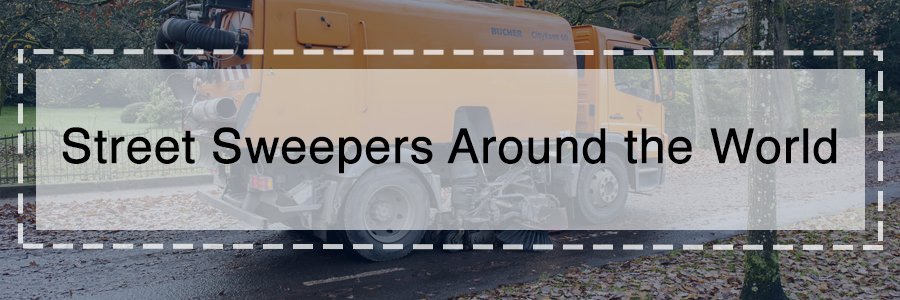
A clean street doesn’t just happen. Sanitary roadways require the work of many dedicated members of the sanitation crew in a particular city or municipality, and street sweepers are the machines that tackle the job of cleaning up the debris that collects on the roadways.
Street sweepers aren’t only used in the U.S. They play an important role in keeping cities clean all over the world, including Europe, Asia, and beyond. A street sweeper may sound like a straightforward piece of equipment, but taking a peek at the street sweepers of the world reveals a wide range in the styles and technology used to keep roadways clean. With different brands dominating markets in certain areas of the world and different demands based on the conditions and environment of various regions, it’s easy to see why the street sweeping machines vary from one country to the next.
History of Street Sweepers
Street sweepers came about in the 19th century in Manchester, England. The city developed tremendously during the Industrial Revolution, making it one of the most industrial cities of the time. With the progress, however, came lots of trash, much of which ended up in the streets. The situation became quite dangerous — streets were full of feces, trash, and other contaminants, creating a very unhealthy environment.
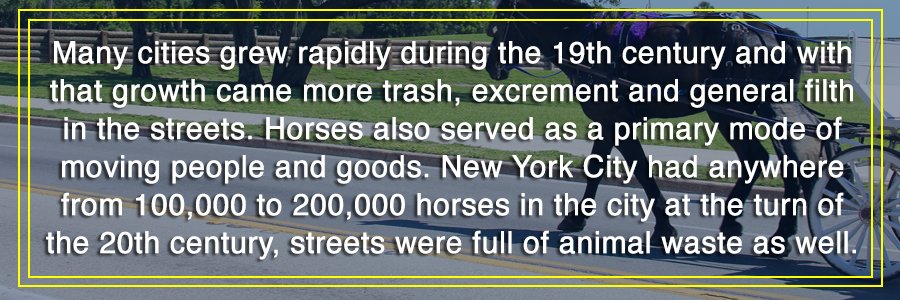
Manchester wasn’t alone in this filthy road situation, either. Many cities grew rapidly during the 19th century. New York City, for instance, went from a population of about 30,000 in 1800 to four million at the turn of the 20th century. With that population growth came more trash, excrement, and general filth that ended up in the streets.
Additionally, with horses serving as a primary mode of moving people and goods — New York City had anywhere from 100,000 to 200,000 horses in the city at the turn of the 20th century — streets were full of animal waste as well. The dirty streets spread illness and created very unsanitary conditions for residents of cities. That unhealthy situation inspired the creation of the modern street sweeper.
The following timeline tracks the development of street sweepers:
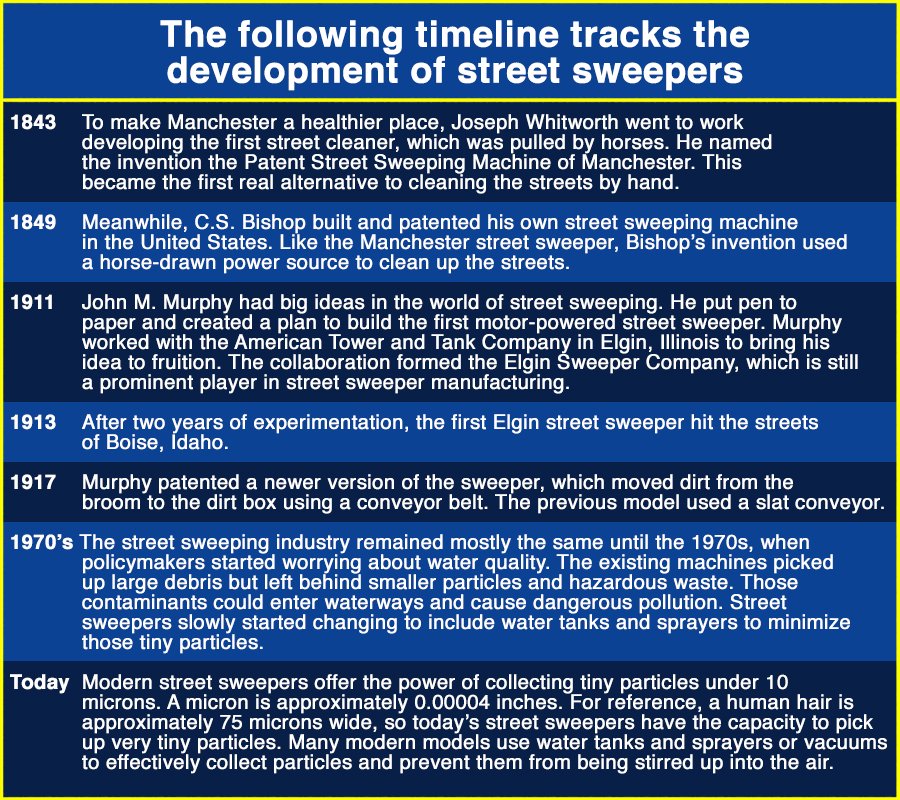
- 1843: To make Manchester a healthier place, Joseph Whitworth went to work developing the first street cleaner, which was pulled by horses. He named the invention the Patent Street Sweeping Machine of Manchester. This became the first real alternative to cleaning the streets by hand.
- 1849: Meanwhile, C.S. Bishop built and patented his own street sweeping machine in the United States. Like the Manchester street sweeper, Bishop’s invention used a horse-drawn power source to clean up the streets.
- 1911: John M. Murphy had big ideas in the world of street sweeping. He put pen to paper and created a plan to build the first motor-powered street sweeper. Murphy worked with the American Tower and Tank Company in Elgin, Illinois to bring his idea to fruition. The collaboration formed the Elgin Sweeper Company, which is still a prominent player in street sweeper manufacturing.
- 1913: After two years of experimentation, the first Elgin street sweeper hit the streets of Boise, Idaho.
- 1917: Murphy patented a newer version of the sweeper, which moved dirt from the broom to the dirt box using a conveyor belt. The previous model used a slat conveyor.
- 1970s: The street sweeping industry remained mostly the same until the 1970s, when policymakers started worrying about water quality. The existing machines picked up large debris but left behind smaller particles and hazardous waste. Those contaminants could enter waterways and cause dangerous pollution. Street sweepers slowly started changing to include water tanks and sprayers to minimize those tiny particles.
- Today: Modern street sweepers offer the power of collecting tiny particles under 10 microns. A micron is approximately 0.00004 inches. For reference, a human hair is approximately 75 microns wide, so today’s street sweepers have the capacity to pick up very tiny particles. Many modern models use water tanks and sprayers or vacuums to effectively collect particles and prevent them from being stirred up into the air.
The overall sanitation may also be better in most countries around the world that it was 100 years ago, but the need for street sweepers is still present. With more vehicles on the road, streets have a variety of debris, including motor oil, other chemicals, and occasionally small pieces of vehicles left from accidents. Modern technology to keep ice off of roads leaves behind a big mess as well, and Mother Nature does her part to contribute to the debris in the form of dirt, leaves, and other natural items. Street cleaners are just as important as ever in keeping cities clean and sanitary.
Types of Street Sweepers
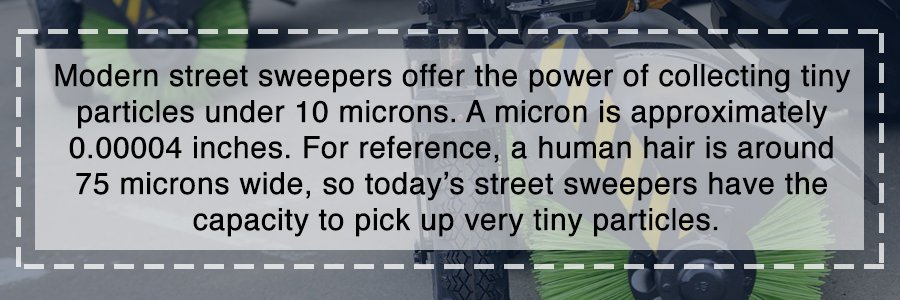
Modern street sweepers utilize use a variety of techniques to clean city streets, each with different advantages. The two primary methods are mechanical brooms and air. While most street sweepers fall into those main categories, the specific model and design are often different to accommodate specific needs in a particular city or geographical area.
The different types of street sweepers around the world include:
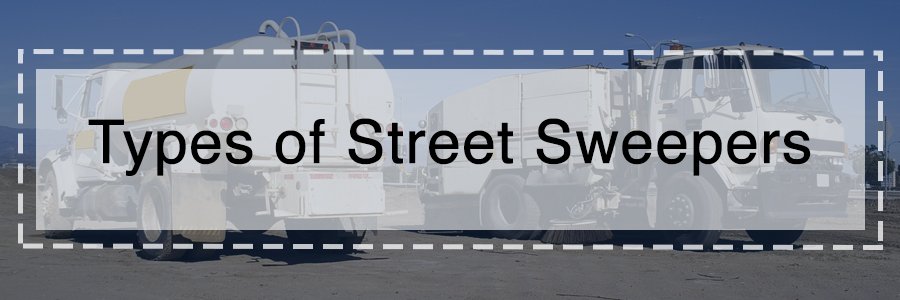
- Regenerative air sweepers: As the name suggests, this type of street sweeper uses air to remove dirt from the streets. Air jets in hydraulic systems loosen the dirt and draw it toward the center of the truck, often in a spiraling motion to keep the debris from flying away before it gets sucked into the hopper. A vacuum created by negative pressure beneath the truck pulls the dirt into the container near the back. The air gets reused after going through a filter. That self-contained air system prevents particles from entering the atmosphere, making regenerative air street sweepers more environmentally friendly than some other models. These trucks also cover the entire lane at once, making them efficient.
- Pure vacuum: Machines using the pure vacuum method are basically giant vacuum cleaners that remove debris from the streets. A fan generates the air that picks up the debris, which moves into the debris hopper. Many vacuum machines also use a brush system to direct the debris toward the vacuum nozzle. The air goes through an exhaust system and out of the machine. Water or side brooms help keep the dirt and tiny particles from going through the exhaust and out into the air. Pure vacuum street sweepers are very effective in removing materials under the suctions nozzles, particularly on roadways with inconsistencies, such as rough patches or potholes. They aren’t as effective in cleaning a wide area all at once.
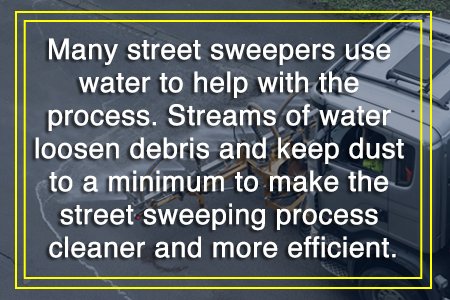
- Mechanical broom sweepers: This type of street sweeper is a popular choice in the industry. This type of machine is basically like a giant automated broom and dustpan. These sweepers use main brooms that run from side to side, rotating and collecting debris. The mess goes up the conveyor belt and into the containment hopper. Water spray nozzles on some models help keep the dust down. Mechanical broom models efficiently pick up large, heavy pieces of debris, but they are not typically as effective in picking up minuscule particles. Sometimes the brushes break up larger debris into small pieces that aren’t as easily swept. They work on varied surfaces, including rough patches and high crowns. Mechanical broom street sweepers also tend to consume less fuel because they don’t use airflow requiring high horsepower. In addition to the primary cleaning technology, many street sweepers use water to help with the process. Streams of water loosen debris and keep dust to a minimum to make the street sweeping process cleaner and more efficient. Some machines rely on a waterless system using fans and filters to control dust. These machines are ideal in cold conditions when water might freeze.
Differences in Street Sweepers Around the World
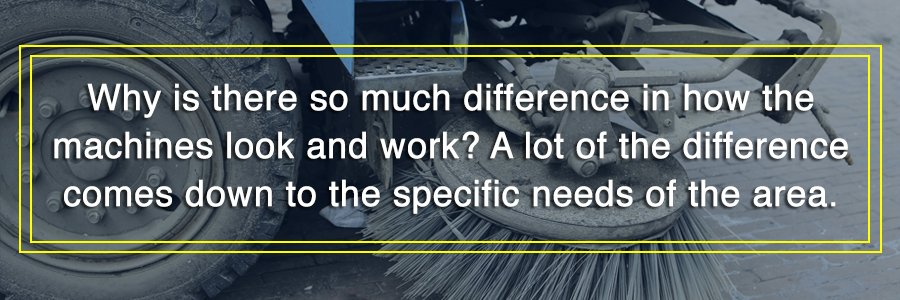
While the technology that powers street sweepers is basically the same no matter where in the world streets need cleaning, the specific design of the machine is often different. Why is there so much difference in how the machines look and work? A lot of the difference comes down to the specific needs of the area.
Here are some factors that influence the style of a street sweeper in a particular country, region, or city:
- Climate: The weather affects the type of sweepers that work best in a particular country or region. For example, in an area with cold winters, sweepers that use water to loosen the debris or minimize dust won’t work because the water can freeze. Snowy areas often use sand or salt for traction and to melt snow as well. Over the course of the winter, that debris can become compacted. It also gets heavy, especially as the amount builds up. Those areas need street sweepers that offer powerful brushing actions and a strong conveyance system to get the sand and salt off the street and into the debris hopper.
- Environmental issues: The environment in a particular area can make sweeping more of a challenge and affect the type of machines that work well. Coastal areas may have lots of blowing sand, for example, and areas with lots of mature trees deal with leaf debris on roadways — making a regenerative air or mechanical system ideal to tackle the mess. In some mountain areas of Switzerland, special street sweepers are used to collect hay that farmers move to the roads.
- City layout: Each city is different in terms of the layout and specific issues that can affect street sweeping. In Europe, narrow streets are often an issue, and many of those streets are made of cobblestone. Street sweepers that use powerful suction or brushes with a fast, powerful spin can knock those cobblestones loose and cause damage to the street. Many heavily populated cities face the challenge of cars parked along the streets at all times. This makes it difficult for street sweepers to fully clean the roads since they can’t reach the areas behind the vehicles. Areas with narrow, crowded streets often use smaller street sweeping machines to tackle those unique challenges.
- Road quality: A flat, smooth road is relatively easy to clean, but many roads are not so easy. Hills, potholes, rough patches and uneven lanes make it more challenging to find a machine to effectively pick up the debris. To add to the complexity, many cities have a variety of different road surfaces and qualities in one stretch. So what are the differences in street sweepers? Check out these traits that may vary based on the specific needs of a city:
- Size: The size of the machine affects the area it can clean effectively. The largest units clean large roadways with just a few passes. The sheer size of the unit lets the driver cover more ground in less time. Cities with large, wide streets or municipalities that need to clean highways might choose a large unit. Smaller units work well in cities with narrow, cramped streets. Smaller street sweepers are often easier to maneuver, which comes in handy when navigating narrow streets.
- Design: Many modern street sweepers are full truck-like units with the motor as part of the machine. Smaller portable machines that get pulled behind another vehicle are also a possibility.
- Debris transport method: The complexity of the machine also varies in certain parts of the world. While many street sweepers use a mechanical belt to move the debris to the hopper, some less sophisticated units use a brush system to get the debris into the hopper.
- Power source: Street sweepers are traditionally powered by diesel fuel. In recent years, the industry has shifted to developing more street sweepers that use alternative fuel sources. This can reduce emissions to meet specific requirements in different parts of the world. These machines also often save money due to the decreased cost of those alternative fuels. Alternative fuel street sweepers are also a better fit for municipalities that put a heavy emphasis on environmental awareness and preservation.
- Size: The size of the machine affects the area it can clean effectively. The largest units clean large roadways with just a few passes. The sheer size of the unit lets the driver cover more ground in less time. Cities with large, wide streets or municipalities that need to clean highways might choose a large unit. Smaller units work well in cities with narrow, cramped streets. Smaller street sweepers are often easier to maneuver, which comes in handy when navigating narrow streets.
Specifics of Street Sweepers in Foreign Countries
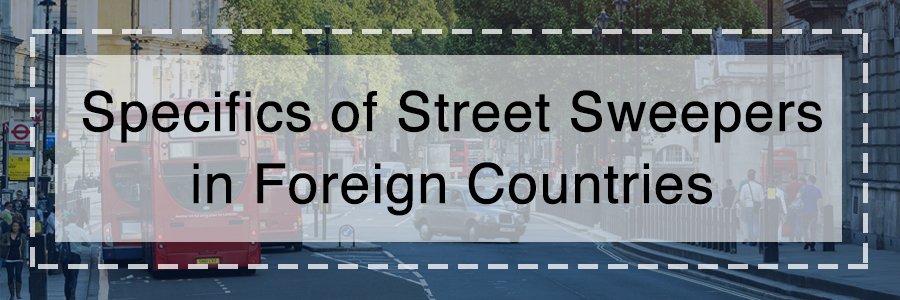
Street sweepers in foreign countries come in many shapes and sizes, and many are customized to the specific needs of that area. For example, many old cities in Europe feature narrow, winding streets sometimes made of cobblestone. Popular travel destinations are often crowded with tourists, presenting an even bigger challenge in keeping the streets clean.
The following examples illustrate the wide range of street sweepers found around the world:
- China and Taiwan: The street sweepers in many Asian countries use a less complicated system, whether the system is a mechanical or regenerative air system. In China and Taiwan in particular, the mechanical street sweepers typically employ two brooms placed vertically on the backside of the hopper to move dirt into the hopper.
- United Kingdom: In the U.K., the manufacturers and street sweeper technology has been limited historically. Vacuum-based technology from the Johnston brand dominates the options in street sweeping in the U.K. Many trucks used to clean streets in the country are small due to the narrow streets in old cities. Southampton is one example of a city that uses smaller machines to fit through narrow streets, which are often lined with cars.
- Copenhagen, Denmark: The city of Copenhagen stays on the cutting-edge of street cleaning and general sanitation. Copenhagen often tests new technology, particularly sweepers and other pieces of equipment that minimize the environmental impact. For example, the city tested a machine that uses small ice crystals applied in a high-pressure blast to remove graffiti and gum. Despite the challenges of uneven roadways, pavers anchored in sand, plenty of tourists and cars always parked on the street, Copenhagen does a good job of keeping the streets clean.
- Amsterdam, Holland: Street sweeping in Amsterdam is often a team effort, using what is called a train system. A water truck leads the train, spraying the road with high-pressure water to release debris and move it away from buildings. A hand-broom crew follows to sweep debris into the path of the sweeper, where it is easier to collect. Air sweepers are used with a controlled RPM to avoid damaging the cobblestone areas of the city. A combination of compact sweepers and slightly larger machines — which are still smaller than most machines used in the U.S. — tackle the street cleaning duties. Some of the machines are equipped with a vacuum hose used to suck up the trash from trash receptacles around the city.
- Heidelberg, Germany: Heidelberg uses a fleet of small air sweepers to manage street sweeping. A few larger sweepers in the fleet tackle the major roads around the city. While many of Heidelberg’s machines use suction, a shift to sand bedding on some of the streets means the city may need to shift to mechanical sweepers instead. Many of the city’s machines use water to keep the dust down, but that makes the machines impossible to use during some parts of winter due to freezing.
Importance of Street Sweepers
Why are street sweepers so important? We may not rely on horses for transportation any longer, and many cities have a robust trash removal and cleaning system, but sanitary streets are still important to the general public. Street sweepers serve more than a purely aesthetic purpose in cities large and small.
Here are a few benefits of street sweeping:
- City beautification: Picking up the dirt and debris from the streets makes the area look nice. It gives the city and its residents a sense of pride in the community. Trash and debris stuck in the streets gives the city a run-down look.
- Public health: Trash in the streets creates an unhealthy situation. Not only can it present a health hazard with chemicals and filth on the streets, but it can also cause slippery or dangerous surfaces for both vehicles and pedestrians. Street cleaners remove those potential hazards to improve the overall health of the city.
- Water safety: The large chunks of debris aren’t the only sources of health issues in a city. When tiny particles are left behind, they wash away when it rains and end up in the storm-water system. Those small particles can pollute the water source. Street sweepers with the technology to pick up those small particles to improve the quality of the water in the city.
- Fish and wildlife health: Removing trash, tiny particles and hazardous materials from streets keep those contaminants away from wildlife and fish.
- Efficiency: Using mechanized street sweepers is a much more efficient way to keep the streets clean. The machines can quickly pick up debris and clean surfaces. Cities equipped with a fleet of street sweepers are able to clean the roads more frequently to prevent a build-up of dirt and debris.
- Construction cleanup: Construction areas have a higher than the normal build-up of dirt, dust, and debris released during the construction process. Street sweepers take on the work of cleaning up that extra debris during times of construction.
Explore Your Street Sweeping Needs
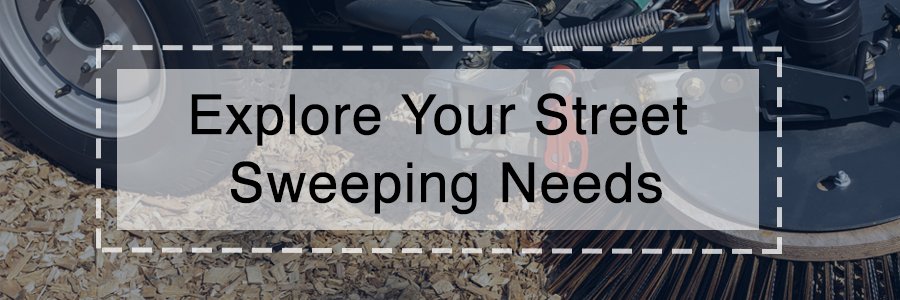
Are you ready to grow your fleet of street sweepers? Whether you live in a sandy coastal climate, cold snowy climate or in hilly terrain, we can help you find a street sweeper that matches your needs. We offer a wide selection of regenerative air, pure vacuum and mechanical broom sweepers, giving you a versatile selection of machines to keep your streets clean.
At Truck Site, most of our inventory consists of ex-government vehicles, many of which come from sunny California, where the dry, clean roads mean our used street sweepers for sale are typically clean and rust-free.
When you choose a used street sweeper from our quality inventory, you get your vehicle quickly since you won’t have to wait for your machine to be built by the manufacturer. Our worldwide shipping process means you can get a quality used street sweeper no matter where you are. To learn more about our inventory of used street sweepers, contact us today.
Back To List